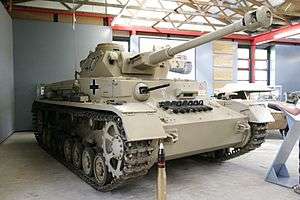Panzer IV
| Panzerkampfwagen IV | |
|---|---|
|
A Panzer IV Ausf G. in desert colors, bearing the palm tree insignia of the 15th Panzer Division of the Afrika Korps | |
| Type | Medium tank |
| Place of origin | Nazi Germany |
| Service history | |
| In service |
1939–1945 (Nazi Germany) 1954[1]–1967 (Syria) |
| Used by |
Nazi Germany Romania Turkey Hungary Bulgaria Italy Finland Spain Croatia Syria |
| Wars | World War II, 1948 Arab–Israeli War, Six-Day War |
| Production history | |
| Designer | Krupp |
| Designed | 1936 |
| Manufacturer | Krupp, Vomag, Nibelungenwerk |
| Unit cost | ≈103,462 Reichsmark[2] |
| Produced | 1936–45 |
| Number built | ≈8,553[3] |
| Variants | StuG IV, Jagdpanzer IV, Wirbelwind, Brummbär |
| Specifications (Pz IV Ausf H, 1943[4]) | |
| Weight | 25.0 tonnes (27.6 short tons; 24.6 long tons) |
| Length |
5.92 metres (19 ft 5 in) 7.02 metres (23 ft 0 in) gun forward |
| Width | 2.88 m (9 ft 5 in) |
| Height | 2.68 m (8 ft 10 in) |
| Crew | 5 (commander, gunner, loader, driver, radio operator/bow machine-gunner) |
|
| |
| Armor |
Front 80 mm (3.1 in) Side 30 mm (1.2 in) Sideskirts 5 mm (0.20 in) Rear 20 mm (0.79 in) |
Main armament | 7.5 cm (2.95 in) KwK 40 L/48 main gun (87 rds.) |
Secondary armament | 2 × 7.92 mm MG 34 machine guns (3,150 rds.) |
| Engine |
12-cylinder Maybach HL 120 TRM V12 300 PS (296 hp, 220 kW) |
| Power/weight | 12 PS (8.8 kW) / tonne |
| Transmission | (Synchromesh ZF SSG 77) 6 forward and 1 reverse ratios |
| Suspension | Leaf spring |
| Fuel capacity | 470 l (120 US gal) |
Operational range | 200 km (120 mi) |
| Speed | 38 km/h (24 mph) to 42 km/h (26 mph) max speed, 25 km/h (16 mph) max sustained road speed 16 km/h (9.9 mph) off road |
The Panzerkampfwagen IV (PzKpfw IV), commonly known as the Panzer IV, was a German medium tank developed in the late 1930s and used extensively during the Second World War. Its ordnance inventory designation was Sd.Kfz. 161.
The Panzer IV was the most widely manufactured German tank of the Second World War, with some 8,500 built. The Panzer IV was used as the base for many other fighting vehicles, including the Sturmgeschütz IV assault gun, Jagdpanzer IV tank destroyer, the Wirbelwind self-propelled anti-aircraft gun, and the Brummbär self-propelled gun.
The Panzer IV saw service in all combat theaters involving Germany and was the only German tank to remain in continuous production throughout the war. Upgrades and design modifications, intended to counter new threats, extended its service life. Generally, these involved increasing the Panzer IV's armor protection or upgrading its weapons, although during the last months of the war, with Germany's pressing need for rapid replacement of losses, design changes also included simplifications to speed up the manufacturing process.
The Panzer IV was partially succeeded by the Panther medium tank, which was introduced to counter the Soviet T-34, although the Panzer IV continued as a significant component of German armoured formations to the end of the war. The Panzer IV was the most widely exported tank in German service, with around 300 sold to Finland, Romania, Spain and Bulgaria. After the war, Syria procured Panzer IVs from France and Czechoslovakia, which saw combat in the 1967 Six-Day War. 8,553 Panzer IVs of all versions were built during World War II, with only the StuG III assault-gun/tank destroyer's 10,086 vehicle production run exceeding the Panzer IV's total among Axis armored forces.
Development history
Origins
The Panzer IV was the brainchild of the German general and innovative armored warfare theorist Heinz Guderian.[5] In concept, it was intended to be a support tank for use against enemy anti-tank guns and fortifications.[6] Ideally, each tank battalion in a panzer division was to have three medium companies of Panzer IIIs and one heavy company of Panzer IVs.[7] On 11 January 1934, the German army wrote the specifications for a "medium tractor", and issued them to a number of defense companies. To support the Panzer III, which would be armed with a 37-millimetre (1.46 in) anti-tank gun, the new vehicle would have a short-barreled, howitzer-like 75-millimetre (2.95 in) as its main gun, and was allotted a weight limit of 24 tonnes (26.46 short tons). Development was carried out under the name Begleitwagen ("accompanying vehicle"),[8] or BW, to disguise its actual purpose, given that Germany was still theoretically bound by the Treaty of Versailles ban on tanks.[9] MAN, Krupp, and Rheinmetall-Borsig each developed prototypes,[7] with Krupp's being selected for further development.[10]
The chassis had originally been designed with a six-wheeled interleaved suspension, but the German Army amended this to a torsion bar system. Permitting greater vertical deflection of the roadwheels, this was intended to improve performance and crew comfort both on- and off-road.[10][11] However, due to the urgent requirement for the new tank, neither proposal was adopted, and Krupp instead equipped it with a simple leaf spring double-bogie suspension, with eight rubber-rimmed roadwheels per side.
The prototype required a crew of five men; the hull contained the engine bay to the rear, with the driver and radio operator, who doubled as the hull machine gunner, seated at the front-left and front-right, respectively. In the turret, the tank commander sat beneath his roof hatch, while the gunner was situated to the left of the gun breech and the loader to the right. The turret was offset 66.5 mm (2.62 in) to the left of the chassis center line, while the engine was moved 152.4 mm (6.00 in) to the right. This allowed the torque shaft to clear the rotary base junction, which provided electrical power to turn the turret, while connecting to the transmission box mounted in the hull between the driver and radio operator. Due to the asymmetric layout, the right side of the tank contained the bulk of its stowage volume, which was taken up by ready-use ammunition lockers.[10]
Accepted into service as the Versuchskraftfahrzeug 622 (Vs.Kfz. 622),[9] production began in 1936 at Fried. Krupp Grusonwerk AG factory at Magdeburg.[12]
Ausf. A to Ausf. F1

The first mass-produced version of the Panzer IV was the Ausführung A (abbreviated to Ausf. A, meaning "Variant A"), in 1936. It was powered by Maybach's HL 108TR, producing 250 PS (183.87 kW), and used the SGR 75 transmission with five forward gears and one reverse,[13] achieving a maximum road speed of 31 kilometres per hour (19.26 mph).[14] As main armament, the vehicle mounted the short-barreled, howitzer-like 75 mm (2.95 in) Kampfwagenkanone 37 L/24 (7.5 cm KwK 37 L/24) tank gun, which was a low-velocity weapon mainly designed to fire high-explosive shells.[15] Against armored targets, firing the Panzergranate (armor-piercing shell) at 430 metres per second (1,410 ft/s) the KwK 37 could penetrate 43 millimetres (1.69 in), inclined at 30 degrees, at ranges of up to 700 metres (2,300 ft).[16] A 7.92 mm (0.31 in) MG 34 machine gun was mounted coaxially with the main weapon in the turret, while a second machine gun of the same type was mounted in the front plate of the hull.[10] The main weapon and coaxial machine gun were sighted with a Turmzielfernrohr 5b optic while the hull machine gun was sighted with a Kugelzielfernrohr 2 optic.[17] The Ausf. A was protected by 14.5 mm (0.57 in) of steel armor on the front plate of the chassis, and 20 mm (0.79 in) on the turret. This was only capable of stopping artillery fragments, small-arms fire, and light anti-tank projectiles.[18]
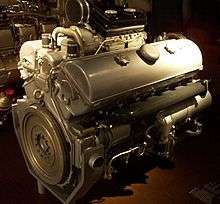
After manufacturing 35 tanks of the A version, in 1937 production moved to the Ausf. B.[9] Improvements included the replacement of the original engine with the more powerful 300 PS (220.65 kW) Maybach HL 120TR, and the transmission with the new SSG 75 transmission, with six forward gears and one reverse gear. Despite a weight increase to 16 t (18 short tons), this improved the tank's speed to 42 kilometres per hour (26.10 mph).[19] The glacis plate was augmented to a maximum thickness of 30 millimetres (1.18 in),[18] while a new driver's visor was installed on the straightened hull front plate, and the hull-mounted machine gun was replaced by a covered pistol port and visor flap.[19] The superstructure width and ammunition stowage were reduced to save weight.[19] A new commander's cupola was introduced which was adopted from the Panzer III Ausf. C.[19] A Nebelkerzenabwurfvorrichtung (smoke grenade discharger rack) was mounted on the rear of the hull starting in July 1938[19] and was back fitted to earlier Ausf. A and Ausf. B chassis starting in August 1938.[20] Forty-two Panzer IV Ausf. Bs were manufactured before the introduction of the Ausf. C in 1938.[9][21] This saw the turret armor increased to 30 mm (1.18 in), which brought the tank's weight to 18.14 t (20.00 short tons).[21] After assembling 40 Ausf. Cs, starting with chassis number 80341, the engine was replaced with the improved HL 120TRM. The last of the 140 Ausf. Cs was produced in August 1939, and production changed to the Ausf. D; this variant, of which 248 vehicles were produced, reintroduced the hull machine gun and changed the turret's internal gun mantlet to a 35 mm (1.38 in)[22] thick external mantlet.[21] Again, protection was upgraded, this time by increasing side armor to 20 mm (0.79 in).[15] As the German invasion of Poland in September 1939 came to an end, it was decided to scale up production of the Panzer IV, which was adopted for general use on 27 September 1939 as the Sonderkraftfahrzeug 161 (Sd.Kfz. 161).[9]
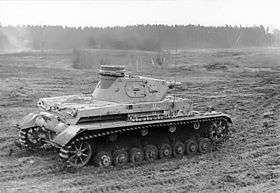
In response to the difficulty of penetrating the armor of British infantry tanks (Matilda and Matilda II) during the Battle of France, the Germans had tested a 50 mm (1.97 in) gun—based on the 5 cm Pak 38 anti-tank gun—on a Panzer IV Ausf. D. However, with the rapid German victory in France, the original order of 80 tanks was canceled before they entered production.[23]
In October 1940, the Ausf. E was introduced. This had 50 millimetres (1.97 in) of armor on the bow plate, while a 30-millimetre (1.18 in) appliqué steel plate was added to the glacis as an interim measure. A new driver's visor, adopted from the Sturmgeschütz III was installed on the hull front plate.[24] A new commander's cupola, adopted from the Panzer III Ausf. G, was relocated forward on the turret eliminating the bulge underneath the cupola.[25] Older model Panzer IV tanks were retrofitted with these features when returned to the manufacturer for servicing. 206 Ausf. Es were produced between October 1940 and April 1941.[3]
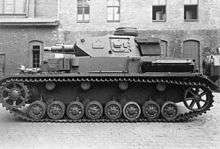
In April 1941, production of the Panzer IV Ausf. F started. It featured 50 mm (1.97 in) single-plate armor on the turret and hull, as opposed to the appliqué armor added to the Ausf. E,[21] and a further increase in side armor to 30 mm (1.18 in).[26] The main engine exhaust muffler was shortened and a compact auxiliary generator muffler was mounted to its left.[24] The weight of the vehicle was now 22.3 tonnes (24.6 short tons), which required a corresponding modification of track width from 380 to 400 mm (14.96 to 15.75 in) to reduce ground pressure. The wider tracks also facilitated the fitting of track shoe "ice sprags", and the rear idler wheel and front sprocket were modified.[27] The designation Ausf. F was changed in the meantime to Ausf. F1, after the distinct new model, the Ausf. F2, appeared. A total of 471 Ausf. F (later temporarily called F1) tanks were produced from April 1941 to March 1942.[3]
Ausf. F2 to Ausf. J
On 26 May 1941, mere weeks before Operation Barbarossa, during a conference with Hitler, it was decided to improve the Panzer IV's main armament. Krupp was awarded the contract to integrate again the 50 mm (1.97 in) Pak 38 L/60 gun into the turret. The first prototype was to be delivered by 15 November 1941.[28] Within months, the shock of encountering the Soviet T-34 medium and KV-1 heavy tanks necessitated a new, much more powerful tank gun.[29] In November 1941, the decision to up-gun the Panzer IV to the 50-millimetre (1.97 in) gun was dropped, and instead Krupp was contracted in a joint development to modify Rheinmetall's pending 75 mm (2.95 in) anti-tank gun design, later known as 7.5 cm Pak 40 L/46. Because the recoil length was too great for the tank's turret, the recoil mechanism and chamber were shortened. This resulted in the 75-millimetre (2.95 in) KwK 40 L/43.[30] When firing an armor-piercing shell, Pzgr. 39, the gun's muzzle velocity was increased from 430 m/s (1,410 ft/s) to 750 m/s (2,460 ft/s).[27] Initially, the gun was mounted with a single-chamber, ball-shaped muzzle brake, which provided just under 50% of the recoil system's braking ability.[31] Firing the Panzergranate 39, the KwK 40 L/43 could penetrate 77 mm (3.03 in) of steel armor at a range of 1,830 m (6,000 ft).[32]
The longer 7.5 cm guns were a mixed blessing. In spite of the designers' efforts to conserve weight, the new weapon made the vehicle nose-heavy to such an extent that the forward suspension springs were under constant compression. This resulted in the tank tending to sway even when no steering was being applied, an effect compounded by the introduction of the Ausführung H in March 1943.[33]
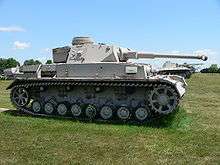
The Ausf. F tanks that received the new, longer, KwK 40 L/43 gun were temporary named Ausf. F2 (with the designation Sd.Kfz. 161/1). The tank increased in weight to 23.6 tonnes (26.0 short tons). Differences between the Ausf. F1 and the Ausf. F2 were mainly associated with the change in armament, including an altered gun mantlet, internal travel lock for the main weapon, new gun cradle, new Turmzielfernrohr 5f optic for the L/43 weapon, modified ammunition stowage, and discontinuing of the Nebelkerzenabwurfvorrichtung in favor of turret mounted Nebelwurfgeraet.[34] Three months after beginning production, the Panzer IV Ausf. F2 was renamed Ausf. G.[35]
During its production run from March 1942 to June 1943, the Panzer IV Ausf. G went through further modifications, including another armor upgrade which consisted of a 30-millimetre (1.18 in) face-hardened appliqué steel plate welded (later bolted) to the glacis—in total, frontal armor was now 80 mm (3.15 in) thick.[36] This decision to increase frontal armor was favorably received according to troop reports on 8 November 1942, despite technical problems of the driving system due to added weight. At this point, it was decided that 50% of Panzer IV production would be fitted with 30 mm (1.18 in) thick additional armor plates. On 5 January 1943, Hitler decided that all Panzer IV should have 80 mm (3.15 in) frontal armor.[37] To simplify production, the vision ports on either side of the turret and the loader's forward vision port in the turret front were removed, while a rack for two spare road wheels was installed on the track guard on the left side of the hull. Complementing this, brackets for seven spare track links were added to the glacis plate. For operation in high temperatures, the engine's ventilation was improved by creating slits over the engine deck to the rear of the chassis, and cold weather performance was boosted by adding a device to heat the engine's coolant, as well as a starter fluid injector. A new light replaced the original headlight and the signal port on the turret was removed.[38] On 19 March 1943, the first Panzer IV with Schürzen skirts on its sides and turret was exhibited.[39] The double hatch for the commander's cupola was replaced by a single round hatch from very late model Ausf. G. and the cupola was up-armored from 50 mm (1.97 in) to 95 mm (3.74 in). In April 1943, the KwK 40 L/43 was replaced by the longer 75-millimetre (2.95 in) KwK 40 L/48 gun, with a redesigned multi-baffle muzzle brake with improved recoil efficiency.[40] The longer L/48 resulted in the introduction of the Turmzielfernrohr 5f/1 optic.[41]
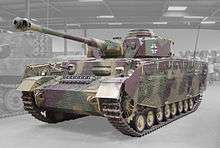
The next version, the Ausf. H, began production in June 1943[3] and received the designation Sd. Kfz. 161/2. The integrity of the glacis armor was improved by manufacturing it as a single 80-millimetre (3.15 in) plate. A reinforced final drive with higher gear ratios was introduced.[42] To prevent adhesion of magnetic anti-tank mines, which the Germans feared would be used in large numbers by the Allies, Zimmerit paste was added to all the vertical surfaces of the tank's armor.[43] The turret roof was reinforced from 10-millimetre (0.39 in) to 16-millimetre (0.63 in) and 25-millimetre (0.98 in) segments.[42] The vehicle's side and turret were further protected by the addition of 5-millimetre (0.20 in) hull skirts and 8-millimetre (0.31 in) turret skirts.[44] This resulted in the elimination of the vision ports located on the hull side,[42] as the skirts obstructed their view. During the Ausf. H's production run its rubber-tired return rollers were replaced with cast steel, a lighter cast front sprocket and rear idler wheel gradually replaced the previous components,[42] the hull was fitted with triangular supports for the easily damaged side skirts, the Nebelwurfgeraet was discontinued, and a mount in the turret roof, designed for the Nahverteidigungswaffe, was plugged by a circular armored plate due to initial production shortages of this weapon.[45][46]
These modifications meant that the tank's weight increased to 25 tonnes (27.56 short tons). In spite of a new six-speed SSG 77 transmission adopted from the Panzer III, top speed dropped to as low as 16 km/h (10 mph) on cross country terrain. An experimental version of the Ausf H was fitted with a hydrostatic transmission but was not put into production.[33]
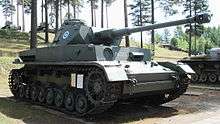
Despite addressing the mobility problems introduced by the previous model, the final production version of the Panzer IV—the Ausf. J—was considered a retrograde from the Ausf. H. Born of necessity, to replace heavy losses, it was greatly simplified to speed production.[47] The electric generator that powered the tank's turret traverse was removed, so the turret had to be rotated manually. The turret traversing mechanism was modified and fitted with a second gear which made hand-operation easier when the vehicle was on sloping terrain.[48] On reasonably level ground, hand operation at 4 seconds to traverse to 12.5° and 29.5 seconds to traverse to 120° was achieved.[48] The resulting space was later used for the installation of an auxiliary 200-litre (53 US gal) fuel tank; road range was thereby increased to 320 km (200 mi),[49] The remaining pistol and vision ports on the turret side hatches were removed, and the engine's radiator housing was simplified by changing the slanted sides to straight sides.[46] Three sockets with screw threads for mounting a 2-ton jib boom crane were welded on the turret roof while the hull roof was thickened from 11-millimetre (0.43 in) to 16-millimetre (0.63 in).[50] In addition, the cylindrical muffler was replaced by two flame-suppressing mufflers. On June 1944 Wa Prüf 6 had decided that because bomb damage at Panzerfirma Krupp in Essen had seriously jeopardized tank production, all plates which should have been face-hardened for the Panzer IV were instead made with rolled homogeneous armour plate.[50] By late 1944, Zimmerit was no longer being applied to German armored vehicles, and the Panzer IV's side-skirts had been replaced by wire mesh, while the gunner's forward vision port in the turret front was eliminated[51] and the number of return rollers was reduced from four to three to further speed-up production.[52]
In a bid to augment the Panzer IV's firepower, an attempt was made to mate a Schmalturm turret — carrying the longer 75 mm (2.95 in) L/70 tank gun from the developing Panther Ausf. F tank design, and partly developed by Rheinmetall from early 1944 onwards — to a Panzer IV hull. This failed and confirmed that the chassis had reached the limit of its adaptability in both weight and available volume.[47]
Production
| Date | Number of vehicles | Variant (Ausf.) |
|---|---|---|
| 1937–1939 | 262 | A – D |
| 1940 | 290 (-24) | D, E |
| 1941 | 480 (+17) | E, F |
| 1942 | 994 | F, G |
| 1943 | 2,983 | G, H |
| 1944 | 3,125 | H, J |
| 1945 | ~435 | J |
| Total | ~8,569 | all |
The Panzer IV was originally intended to be used only on a limited scale, so initially Krupp was its sole manufacturer. Prior to the Polish campaign, only 217 Panzer IVs were produced: 35 Ausf. A; 42 Ausf. B; and 140 Ausf. C; in 1941, production was extended to Vogtländische Maschinenfabrik("VOMAG") (located in the city of Plauen) and the Nibelungenwerke in the Austrian city of St. Valentin.[3]
In 1941, an average of 39 tanks per month were built; this rose to 83 in 1942, 252 in 1943, and 300 in 1944. However, in December 1943, Krupp's factory was diverted to manufacture the Sturmgeschütz IV and, in the spring of 1944, the Vomag factory began production of the Jagdpanzer IV, leaving the Nibelungenwerke as the only plant still assembling the Panzer IV.[53] With the slow collapse of German industry under pressure from Allied air and ground offensives—in October 1944 the Nibelungenwerke factory was severely damaged during a bombing raid—by March and April 1945, production had fallen to pre-1942 levels, with only around 55 tanks per month coming off the assembly lines.[54]
Export
The Panzer IV was the most exported German tank of the Second World War.[55] In 1942, Germany delivered 11 tanks to Romania and 32 to Hungary, many of which were lost on the Eastern Front between the final months of 1942 and the beginning of 1943 during the battles around Stalingrad.[56] Romania received approximately 120 Panzer IV tanks of different models throughout the entire war.[57] To arm Bulgaria, Germany supplied 46[58] or 91[59] Panzer IVs, and offered Italy 12 tanks to form the nucleus of a new armored division. These were used to train Italian crews while the Italian dictator Benito Mussolini was deposed, but were retaken by Germany during its occupation of Italy in mid-1943.[58] The Spanish government petitioned for 100 Panzer IVs in March 1943, but only 20 were ever delivered, by December.[60] Finland bought 30, but only received 15 in 1944, and the same year a second batch of 62[58] or 72[59] was sent to Hungary (although 20 of these were diverted to replace German losses).[59] In total, 297 Panzer IVs of all models were delivered to Germany's allies.[61]
Combat history

The Panzer IV was the only German tank to remain in both production and combat throughout World War II,[62][63] and measured over the entire war it comprised 30% of the Wehrmacht's total tank strength.[64] Although in service by early 1939, in time for the occupation of Czechoslovakia,[65] at the start of the war the majority of German armor was made up of obsolete Panzer Is and Panzer IIs.[66] The Panzer I in particular had already proved inferior to Soviet tanks, such as the T-26, during the Spanish Civil War.[67]
Western Front and North Africa (1939–1942)
When Germany invaded Poland on 1 September 1939, its armored corps was composed of 1,445 Panzer Is, 1,223 Panzer IIs, 98 Panzer IIIs and 211 Panzer IVs; the more modern vehicles amounted to less than 10% of Germany's armored strength.[68] The 1st Panzer Division had a roughly equal balance of types, with 17 Panzer Is, 18 Panzer IIs, 28 Panzer IIIs, and 14 Panzer IVs per battalion. The remaining panzer divisions were heavy with obsolete models, equipped as they were with 34 Panzer Is, 33 Panzer IIs, 5 Panzer IIIs, and 6 Panzer IVs per battalion.[69] Although the Polish Army possessed less than 200 tanks capable of penetrating the German light tanks, Polish anti-tank guns proved more of a threat, reinforcing German faith in the value of the close-support Panzer IV.[70]
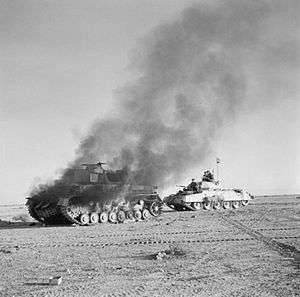
Despite increased production of the medium Panzer IIIs and IVs prior to the German invasion of France on 10 May 1940, the majority of German tanks were still light types. According to Heinz Guderian, the Wehrmacht invaded France with 523 Panzer Is, 955 Panzer IIs, 349 Panzer IIIs, 278 Panzer IVs, 106 Panzer 35(t)s and 228 Panzer 38(t)s.[71] Through the use of tactical radios[72] and superior tactics, the Germans were able to outmaneuver and defeat French and British armor.[73] However, Panzer IVs armed with the KwK 37 L/24 75-millimetre (2.95 in) tank gun found it difficult to engage French tanks such as Somua S35 and Char B1.[74] The Somua S35 had a maximum armor thickness of 55 mm (2.17 in),[75] while the KwK 37 L/24 could only penetrate 43 mm (1.69 in) at a range of 700 m (2,296.59 ft).[16] The British Matilda II was also heavily armored, with at least 70 mm (2.76 in) of steel on the front and turret, and a minimum of 65 mm on the sides.[76] but were few in number.
Although the Panzer IV was deployed to north Africa with the German Afrika Korps, until the longer gun variant began production, the tank was outperformed by the Panzer III with respect to armor penetration.[77] Both the Panzer III and IV had difficulty in penetrating the British Matilda II's thick armor, while the Matilda's 40-mm QF 2 pounder gun could knock out either German tank; its major disadvantage was its low speed.[78] By August 1942, Rommel had only received 27 Panzer IV Ausf. F2s, armed with the L/43 gun, which he deployed to spearhead his armored offensives.[78] The longer gun could penetrate all American and British tanks in theater at ranges of up to 1,500 m (4,900 ft), by that time the most heavily armored of which was the M3 Grant.[79] Although more of these tanks arrived in North Africa between August and October 1942, their numbers were insignificant compared to the amount of matériel shipped to British forces.[80]
The Panzer IV also took part in the invasion of Yugoslavia and the invasion of Greece in early 1941.[81]
Eastern Front (1941–1945)
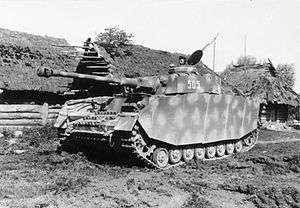
With the launching of Operation Barbarossa on 22 June 1941, the unanticipated appearance of the KV-1 and T-34 tanks prompted an upgrade of the Panzer IV's 75 mm (2.95 in) gun to a longer, high-velocity 75 mm gun suitable for anti-tank use. This meant that it could now penetrate the T-34 at ranges of up to 1,200 m (3,900 ft) at any angle.[82] The 75 mm KwK 40 L/43 gun on the Panzer IV could penetrate a T-34 at a variety of impact angles beyond 1,000 m (3,300 ft) range and up to 1,600 m (5,200 ft).[83] Shipment of the first model to mount the new gun, the Ausf. F2, began in spring 1942, and by the summer offensive there were around 135 Panzer IVs with the L/43 tank gun available. At the time, these were the only German tanks that could defeat T-34 or KV-1 with sheer firepower.[84] They played a crucial role in the events that unfolded between June 1942 and March 1943,[85] and the Panzer IV became the mainstay of the German panzer divisions.[86] Although in service by late September 1942, the Tiger I was not yet numerous enough to make an impact and suffered from serious teething problems, while the Panther was not delivered to German units in the Soviet Union until May 1943.[87] The extent of German reliance on the Panzer IV during this period is reflected by their losses; 502 were destroyed on the Eastern Front in 1942.[88]
The Panzer IV continued to play an important role during operations in 1943, including at the Battle of Kursk. Newer types, such as the Panther, were still experiencing crippling reliability problems that restricted their combat efficiency,[89] so much of the effort fell to the 841 Panzer IVs that took part in the battle.[90] Throughout 1943, the German army lost 2,352 Panzer IVs on the Eastern Front;[91] some divisions were reduced to 12–18 tanks by the end of the year.[86] In 1944, a further 2,643 Panzer IVs were destroyed, and such losses were becoming increasingly difficult to replace.[92] Nevertheless, due to a shortage of replacement Panther tanks, the Panzer IV continued to form the core of Germany's armored divisions, including elite units such as the II SS Panzer Corps, through 1944.[93]
In January 1945, 287 Panzer IVs were lost on the Eastern Front. It is estimated that combat against Soviet forces accounted for 6,153 Panzer IVs, or about 75% of all Panzer IV losses during the war.[94]
Western Front (1944–45)
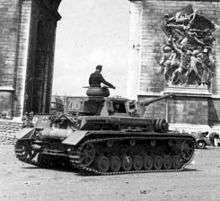
Panzer IVs comprised around half of the available German tank strength on the Western Front prior to the Allied invasion of Normandy on 6 June 1944.[95] Most of the 11 panzer divisions that saw action in Normandy initially contained an armored regiment of one battalion of Panzer IVs and another of Panthers, for a total of around 160 tanks, although Waffen-SS panzer divisions were generally larger and better-equipped than their Heer counterparts.[96][97] Regular upgrades to the Panzer IV had helped to maintain its reputation as a formidable opponent.[95] The bocage countryside in Normandy favored defense, and German tanks and anti-tank guns inflicted very heavy casualties on Allied armor during the Normandy campaign, despite the overwhelming Allied air superiority. German counter-attacks were blunted in the face of Allied artillery, infantry-held anti-tank weapons, tank destroyers and anti-tank guns, as well as the ubiquitous fighter bomber aircraft.[98] The rugged terrain caused the side-skirt armor used to predetonate shaped charge anti-tank weapons, such as the British PIAT, to be pulled away. German tankers in all theaters were "frustrated by the way these skirts were easily torn off when going through dense brush.[95]
The Allies had also been developing lethality improvement programs of their own; the widely used American-designed M4 Sherman medium tank, while mechanically reliable, suffered from thin armor and an inadequate gun.[99] Against earlier-model Panzer IVs, it could hold its own, but with its 75 mm M3 gun, struggled against the late-model Panzer IV (and was unable to penetrate the frontal armor of Panther and Tiger tanks at virtually any range).[100] The late-model Panzer IV's 80 mm (3.15 in) frontal hull armor could easily withstand hits from the 75 mm (2.95 in) weapon on the Sherman at normal combat ranges,[101] though the turret remained vulnerable.
The British up-gunned the Sherman with their highly effective QF 17 pounder anti-tank gun, resulting in the Firefly;[102] although this was the only Allied tank capable of dealing with all current German tanks at normal combat ranges, few (342) were available in time for the Normandy invasion.[99] From D-Day to the end of the Normandy campaign, a further 550 Fireflies were built.[103] A second British tank equipped with the 17pdr gun, the Cruiser Mk VIII Challenger, could not participate in the initial landings having to wait for port facilities to be ready to land. It was not until July 1944 that American Shermans, fitted with the 76-mm (3-inch) M1 tank gun, achieved a parity in firepower with the Panzer IV.[104][105]
However, despite the general superiority of its armored vehicles, by 29 August 1944, as the last surviving German troops of Fifth Panzer Army and Seventh Army began retreating towards Germany, the twin cataclysms of the Falaise Pocket and the Seine crossing had cost the Wehrmacht dearly. Of the 2,300 tanks and assault guns it had committed to Normandy (including around 750 Panzer IVs[106]), over 2,200 had been lost.[107] Field Marshal Walter Model reported to Hitler that his panzer divisions had remaining, on average, five or six tanks each.[107]
During the winter of 1944–45, the Panzer IV was one of the most widely used tanks in the Ardennes offensive, where further heavy losses—as often due to fuel shortages as to enemy action—impaired major German armored operations in the West thereafter.[108] The Panzer IVs that took part were survivors of the battles in France between June and September 1944, with around 260 additional Panzer IV Ausf. Js issued as reinforcements.[106]
Other users
The Finns bought 15 new Panzer IV Ausf J in 1944, for 5,000,000 Finnish markkas each[109] (about twice the production price). The remainder of an order for 40 tanks and some StuG were not delivered and neither were German instructors provided. The tanks arrived too late to see action against the Soviets, but were instead used against the Germans during their withdrawal through Lapland. After the war, they served as training tanks, and one portrayed a Soviet KV-1 tank in the movie The Unknown Soldier in 1955.
The additional weight, going from the 18.4 tons (Ausf A) to about 25 tons(Ausf J), of these modifications strained the chassis. The overloaded and primitive leaf-spring suspension gave its crew a shaky ride, earning the Panzer IV the nickname "ravistin" ("shaker") in Finnish Service. This not only affected crew comfort, but also hampered the accurate aiming of the main gun. What exactly caused this vibration that gave the PzKw IVJ such a bad name among Finnish tank crews remains somewhat unclear, but suspension seems to be the most likely suspect.[110]
After 1945, Bulgaria incorporated its surviving Panzer IVs into defensive bunkers as gunpoints on the border with Turkey, along with T-34 turrets. This defensive line known as the "Krali Marko Line", remained in use until the fall of communism in 1989.
Twenty Panzer IV Ausf Hs and ten StuG III Ausf Gs were supplied to Spain in December 1943, a small fraction of what Spain had originally asked for. The Panzer IV represented the best tank in Spanish service between 1944 and 1954, and was deployed along with T-26s and Panzer Is. Spain sold 17 Panzer IVs to Syria in 1967; the remaining three are conserved. These can be found at Madrid, Burgos and Santovenia de Pisuerga (Valladolid).
Most of the tanks Romania had received were lost during combat in 1944 and 1945. These tanks, designated T4 in the army inventory, were used by the 2nd Armored Regiment.
On 9 May 1945, only two Panzer IVs were left. Romania received another 50 Panzer IV tanks from the Red Army after the end of the war. These tanks were of different models and were in very poor shape[57]—many of them were missing parts and the side skirts. The T4 tanks remained in service until 1950, when the Army decided to use only Soviet equipment. By 1954, all German tanks had been scrapped.
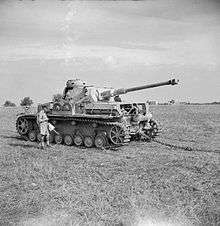
While their numbers remain uncertain, Syria received around 60 Panzers that were refurbished in France during 1950-1952, followed by 50 others purchased from Czechoslovakia in 1954.[111] A Soviet DShK machine gun on an anti-aircraft mount was retrofitted on the cupola. These were used to shell Israeli settlements below the Golan Heights, and were fired upon in 1965 during the Water War by Israeli Centurion tanks.[108] Syria received 17 Panzer IVs from Spain; these saw combat during the Six-Day War in 1967.[112]
In addition, Turkey was a buyer, with 35 Panzer IV received until 4 May 1944 in exchange for some chromium. Delivery began with the Ausf G and probably went on with Ausf H versions.[113]
Captured Panzer IVs in service
The Soviet Army captured large numbers of German armored vehicles, including Panzer IVs (Russian designation T-4). Some of them were pressed into temporary service and some others were used for training. Sometimes, captured tanks were used in different temporary units or as single tanks. While captured Tigers and Panthers were only permitted to be used until they broke down, the simplicity of the Panzer IV and the large number of captured parts allowed for repair and continued use.
At least one captured Panzer IV ausf. H was used by the Warsaw Tank Brigade of the Polish 2nd Corps in Italy during 1944.
The 1st GMR (Groupement Mobile de Reconnaissance) of the FFI (French Forces of the Interior), later called 'escadron autonome de chars Besnier', was equipped in December 1944 with at least one Panzer IV.
Variants
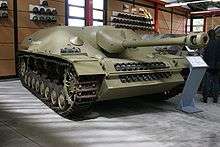

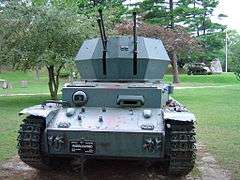
In keeping with the wartime German design philosophy of mounting an existing anti-tank gun on a convenient chassis to give mobility, several tank destroyers and infantry support guns were built around the Panzer IV hull. Both the Jagdpanzer IV, initially armed with the 75-millimetre (2.95 in) L/48 tank gun,[114] and the Krupp-manufactured Sturmgeschütz IV, which was the casemate of the Sturmgeschütz III mounted on the body of the Panzer IV,[115] proved highly effective in defense. Cheaper and faster to construct than tanks, but with the disadvantage of a very limited gun traverse, around 1,980 Jagdpanzer IVs[116] and 1,140 Sturmgeschütz IVs[117] were produced. Another tank destroyer, the Panzer IV/70, used the same basic 75 millimeter L/70 gun that was mounted on the Panther.[118][119]
Another variant of the Panzer IV was the Panzerbefehlswagen IV (Pz. Bef. Wg. IV) command tank. This conversion entailed the installation of additional radio sets, mounting racks, transformers, junction boxes, wiring, antennas and an auxiliary electrical generator. To make room for the new equipment, ammunition stowage was reduced from 87 to 72 rounds. The vehicle could coordinate with nearby armor, infantry or even aircraft. Seventeen Panzerbefehlswagen were built on Ausf. J chassis in August and September 1944,[3] while another 88 were based on refurbished chassis.[120]
The Panzerbeobachtungswagen IV (Pz. Beob. Wg. IV) was an artillery observation vehicle built on the Panzer IV chassis. This, too, received new radio equipment and an electrical generator, installed in the left rear corner of the fighting compartment. Panzerbeobachtungswagens worked in cooperation with Wespe and Hummel self-propelled artillery batteries.[121]
Also based on the Panzer IV chassis was the Sturmpanzer IV 150-millimetre (5.91 in) infantry-support self-propelled gun. These vehicles were primarily issued to four Sturmpanzer units (Numbers 216, 217, 218 and 219) and used during the battle of Kursk and in Italy in 1943. Two separate versions of the Sturmpanzer IV existed, one without a machine gun in the mantlet and one with a machine gun mounted on the mantlet of the casemate.[122] Furthermore, a 105-millimetre (4.13 in) artillery gun was mounted in an experimental demountable turret on a Panzer IV chassis. This variant was called the Heuschrecke ("Grasshopper").[123] Another 105 mm artillery/anti-tank prototype was the 10.5 cm K (gp.Sfl.) nicknamed Dicker Max.
Four different self-propelled anti-aircraft vehicles were built on the Panzer IV hull. The Flakpanzer IV Möbelwagen was armed with a 37-millimetre (1.46 in) anti-aircraft cannon; 240 were built between 1944 and 1945. In late 1944 a new Flakpanzer, the Wirbelwind ("Whirlwind"), was designed, with enough armor to protect the gun's crew and a rotating turret, armed with the quadruple 20 mm Flakvierling anti-aircraft cannon system; at least 100 were manufactured. Sixty-five similar vehicles were built, named Ostwind ("East wind"), but with a single 37-millimetre (1.46 in) anti-aircraft cannon instead. This vehicle was designed to replace the Wirbelwind. The final model was the Flakpanzer IV Kugelblitz, of which only five pilot vehicles were built. This vehicle featured an enclosed turret armed with twin 30-millimetre (1.18 in) anti-aircraft cannons.[124]
Although not a direct modification of the Panzer IV, some of its components, in conjunction with parts from the Panzer III, were utilized to make one of the most widely used self-propelled artillery chassis of the war—the Geschützwagen III/IV. This chassis was the basis of the Hummel artillery piece, of which 666 were built, and also the 88 millimetres (3.46 in) gun armed Nashorn tank destroyer, with 473 manufactured.[125] To resupply self-propelled howitzers in the field, 150 ammunition carriers were manufactured on the Geschützwagen III/IV chassis.[65]
Another rare variant was the Bergepanzer IV armored recovery vehicle. Some were believed to have been converted locally,[126] 21 were converted from hulls returned for repair between October 1944 and January 1945. The conversion involved removing the turret and adding a wooden plank cover with an access hatch over the turret ring and the addition of a 2-ton jib crane and rigid towing bars.[127]
Production models
- Ausf.A, 1/BW (Sd.Kfz.161)
- 35 produced by Krupp-Gruson, between November 1937 and June 1938.
- Ausf.B, 2/BW
- 42 produced by Krupp-Gruson, from May to October 1938.
- Ausf.C, 3/BW
- 140 produced by Krupp-Gruson, from October 1938 to August 1939.
- Ausf.D, 4/BW + 5/BW
- 200 + 48 produced by Krupp-Gruson, from October 1939 to October 1940.
- Ausf.E, 6/BW
- 206 produced by Krupp-Gruson, from October 1940 to April 1941.
- Ausf.F, 7/BW
- 471 produced by Krupp-Gruson, Vomag and Nibelungenwerke from April 1941 to March 1942.
- Ausf.F2, 7/BW (Sd.Kfz.161/1)
- Temporary designation for Ausf F chassis built with long 7.5cm KwK40 L/43 main gun, later renamed into Auf. G and 8/BW.
- Ausf.G, 8/BW
- 1,927 produced by Krupp-Gruson, Vomag and Nibelungenwerke from March 1942 to June 1943.
- Ausf.H, 9/BW (Sd.Kfz.161/2)
- ~2,324 produced by Krupp-Gruson, Vomag and Nibelungenwerke from June 1943 to February 1944.
- Ausf.J, 10/BW
- ~3,160 produced by Vomag Nibelungenwerke from February 1944 to April 1945.
Variants based on chassis
- Tauchpanzer IV: :42 converted from July 1940 as submersible medium support tanks.
- Panzerbefehlswagen: command tank with additional radio equipment, 17 built on Ausf. J and further 88 on rebuilt chassis
- Panzerbeobachtungswagen IV: artillery spotter tank with special radio equipment, 133 converted from Ausf. J
- Sturmpanzer IV: Heavy Assault gun armed with 150 mm Infantry gun
- Sturmgeschütz IV: Assault gun, similar to StuG III, armed with 7.5 cm gun
- Jagdpanzer IV and Panzer IV/70: tank destroyer armed with 7.5 cm gun
- Nashorn: Heavy Panzerjäger armed with 8.8 cm Anti-tank gun
- Hummel: Self-propelled artillery armed with 150 mm Howitzer
- Flakpanzer IV, multiple variants of Panzer IV chassis armed with various Flak guns
- Brückenleger IV b+c: 20+4 bridge layer tanks built by Krupp and Magirus, on Ausf.C and Ausf.D chassis, from February to May 1940.
- Brückenleger IV s (Sturmstegpanzer): 4 assault bridge carriers converted from Ausf.C chassis in 1940.
- Bergepanzer IV: 21 armoured recovery vehicles converted from Pz IV chassis from October to December 1944.
See also
- List of military vehicles of World War II
- List of World War II military vehicles of Germany
- List of SdKfz designations
- Panzer III/IV
Tanks of comparable role, performance and era
- Australia Sentinel
- British Cromwell
- Canadian Ram II
- Hungarian Turán III
- Italian Carro Armato P 40
- Japanese Type 3 Chi-Nu
- Soviet T-34
- Swedish Stridsvagn m/42
- United States M4 Sherman
Notes
- ↑ Ginat, Rami (6 Dec 2006). The Soviet Union and the Syrian Ba'th regime: from hesitation to rapprochement. Middle Eastern Studies. p. 9.
- ↑ Zetterling, Niklas (2000). Kursk 1943: A Statistical Analysis. London: Frank Cass. p. 61. ISBN 978-0-7146-5052-4.
- 1 2 3 4 5 6 7 Thomas L. Jentz and Hilary Louis Doyle (2011). Panzer Tracts No.23 - Panzer Production from 1933 to 1945. Panzer Tracts. pp. 50–59.
- ↑ Conners, Chris (4 December 2002). "Panzerkampfwagen IV Ausfuehrung H". The AFV Database. Retrieved 15 December 2010.
- ↑ Spielberger (1972), p. 69
- ↑ Caballero & Molina (2006), p. 5
- 1 2 Perrett (1999), p. 4
- ↑ Jentz (1997), p. 1
- 1 2 3 4 5 Spielberger (1972), p. 70
- 1 2 3 4 Perrett (1999), p. 5
- ↑ Simpkin (1979), p. 106
- ↑ de Mazarrasa (1994), p. 46
- ↑ Perrett (1999), p. 5; Caballero & Molina (2006), p. 6
- ↑ Caballero & Molina (2006), p. 6
- 1 2 Caballero & Molina (2006), p. 7
- 1 2 Doyle & Jentz (2001), p. 4
- ↑ Jentz, Doyle, and Louis (1997) p. 18
- 1 2 Perrett (1999), p. 6; Caballero & Molina (2006), p. 7
- 1 2 3 4 5 Jentz, Doyle, and Louis (1997) p. 20
- ↑ Jentz, Thomas L.; Doyle, Hilary Louis (1997). Panzer Tracts No. 4: Panzerkampfwagen IV Grosstraktor to Panzerbefehlswagen IV. Darlington (MD), p. 14: Darlington Productions.
- 1 2 3 4 Perrett (1999), p. 6
- ↑ Jentz, Thomas L.; Doyle, Hilary Louis (1997). Panzer Tracts No. 4: Panzerkampfwagen IV Grosstraktor to Panzerbefehlswagen IV. Darlington (MD), p. 30: Darlington Productions.
- ↑ Doyle & Jentz (2001), p. 5
- 1 2 Jentz, Thomas L.; Doyle, Hilary Louis (1997). Panzer Tracts No. 4: Panzerkampfwagen IV Grosstraktor to Panzerbefehlswagen IV. Darlington (MD), p. 40: Darlington Productions.
- ↑ Jentz, Thomas L.; Doyle, Hilary Louis (1997). Panzer Tracts No. 4: Panzerkampfwagen IV Grosstraktor to Panzerbefehlswagen IV. Darlington (MD), p. 34: Darlington Productions.
- ↑ Caballero & Molina (2006), p. 31
- 1 2 Spielberger (1972), p. 71
- ↑ Spielberger (1993)
- ↑ Perrett (1999), p.7
- ↑ Doyle & Jentz (2001), pp. 6–7
- ↑ Doyle & Jentz (2001), p. 7
- ↑ Spielberger (1972), p. 73
- 1 2 Perrett, Bryan; Laurier, Jim (1999). Panzerkampfwagen IV Medium Tank 1936-45. Osprey. p. 8. ISBN 1855328437.
- ↑ Jentz, Thomas L.; Doyle, Hilary Louis (1997). Panzer Tracts No. 4: Panzerkampfwagen IV Grosstraktor to Panzerbefehlswagen IV. Darlington (MD), p. 44: Darlington Productions.
- ↑ Doyle & Jentz (2001), p. 8
- ↑ Caballero & Molina (2006), p. 38
- ↑ Spielberger (1993), p. 59
- ↑ Doyle & Jentz (2001), pp. 11–12
- ↑ Walter J. Spielberger (1993), P63
- ↑ Doyle & Jentz (2001), p. 12
- ↑ Chamberlain, Peter; Doyle, Hilary Louis (2001). Encyclopedia Of German Tanks Of World War Two. London, p. 255: Arms & Armour Press.
- 1 2 3 4 Jentz, Thomas L.; Doyle, Hilary Louis (1997). Panzer Tracts No. 4: Panzerkampfwagen IV Grosstraktor to Panzerbefehlswagen IV. Darlington (MD), p. 50: Darlington Productions.
- ↑ Caballero & Molina (2006), p. 44
- ↑ Perrett (1999), p. 8
- ↑ Doyle & Jentz (2001), p. 13
- 1 2 Doyle & Jentz (2001), p. 14
- 1 2 Perrett (1999), p. 9
- 1 2 Doyle & Friedli (2016), p. 56
- ↑ Caballero & Molina (2006), pp. 53–54
- 1 2 Doyle & Friedli (2016), p. 57
- ↑ Doyle & Friedli (2016), p. 58
- ↑ Doyle & Jentz (2001), p. 15
- ↑ Spielberger (1972), p. 72
- ↑ Doyle & Jentz (2001), p. 16
- ↑ Caballero & Molina (2006), p. 63
- ↑ Caballero & Molina (2006), pp. 63–66
- 1 2 Scafes and Serbanescu 2005, p.78
- 1 2 3 Caballero & Molina (2006), p. 66
- 1 2 3 Doyle & Jentz (2001), p. 41; Perrett (1999), p. 44, claims Bulgaria received 88 Panzer IVs.
- ↑ Caballero & Molina (2006), pp. 76–82
- ↑ Caballero & Molina (2006), p. 67
- ↑ McCarthy & Syron (2002), p. 36
- ↑ Caballero & Molina (2006), p. 4
- ↑ Caballero & Molina (2006), p. 3
- 1 2 Spielberger (1972), p. 82
- ↑ McCarthy & Syron (2002), p. 51
- ↑ McCarthy & Syron (2002), p. 34
- ↑ Perrett (1999), p. 24
- ↑ Perrett (1998), p. 37
- ↑ Perrett (1999), p. 33
- ↑ Guderian (1996), p. 472
- ↑ McCarthy & Syron (2002), p. 72
- ↑ McCarthy & Syron (2002), p. 73
- ↑ Doyle & Jentz (2001), pp. 4–5
- ↑ Crawford (2000), p. 4
- ↑ Crawford (2000), p. 50
- ↑ Perrett (1999), p. 34
- 1 2 Ormeño (2007), p. 48
- ↑ Doyle & Jentz (2001), p. 21
- ↑ Doyle & Jentz (2001), p. 23
- ↑ Perrett (1999), pp. 34–35
- ↑ Jentz (1996), p. 243
- ↑ Bird & Livingston (2001), p. 25
- ↑ Doyle & Jentz (2001), p. 33
- ↑ Doyle & Jentz (2001), p. 35–36
- 1 2 Spielberger (1972), p. 87
- ↑ Caballero & Molina (2006), p. 42
- ↑ Caballero & Molina (2006), p. 39
- ↑ Perrett (1999), p. 39
- ↑ Caballero & Molina (2006), p. 47
- ↑ Caballero & Molina (2006), p. 48
- ↑ Caballero & Molina (2006), p. 51
- ↑ Reynolds (2002), p. 5
- ↑ Caballero & Molina (2006), pp. 59–62
- 1 2 3 Hastings (1999), p. 133
- ↑ Hastings (1999), p. 413
- ↑ Forty (2000), p. 88
- ↑ Perrett (1999), p. 43
- 1 2 Hastings (1999), p. 225
- ↑ Hastings (1999), pp. 225–227
- ↑ Jentz & Doyle (2001), p. 176
- ↑ Fletcher (2008), pp. 5–8
- ↑ Hart, Stephen (2007). Sherman Firefly vs Tiger. Osprey Publishing
- ↑ Fletcher (2008), p. 43
- ↑ Hastings (1999), p. 221
- 1 2 Forty (2000), p. 92
- 1 2 Wilmott (1997), p. 434
- 1 2 Perrett (1999), p. 44
- ↑ "Panzer IV". www.legionsgames.com. Legions Hobbies and Games. Retrieved 11 August 2011.
- ↑ "KV-1 AND PzKw IVJ TANKS". JAEGER PLATOON: FINNISH ARMY 1918 - 1945 WEBSITE.
- ↑ Naud, Phillipe (2011), "Les Blindes de Damas 1948-1967", in Steel Masters nº105, May–June, 2011
- ↑ de Mazarrasa (1994), p. 50
- ↑ Official document in Turkish Republic Archive, BCA: 10.52.344.9
- ↑ Scheibert (1991), p. 38
- ↑ Scheibert (1991), p. 37
- ↑ Parada, George. "Jagdpanzer IV". achtungpanzer.com. Retrieved 2008-09-01.
- ↑ Parada, George. "Sturmgeschütz III / IV". achtungpanzer.com. Retrieved 2008-09-01.
- ↑ Scheibert (1991), p. 44
- ↑ Jentz, Thomas L.; Doyle, Hilary Louis (1997). Panzer Tracts No. 9: Jagdpanzer, Jagdpanzer 38 to Jagdtiger. Darlington (MD): Darlington Productions.
- ↑ Doyle & Jentz (2001), pp. 41–42
- ↑ Doyle & Jentz (2001), pp. 42–43
- ↑ Scheibert (1991), pp. 32–33
- ↑ Scheibert (1991). p. 43
- ↑ Scheibert (1991), pp. 37–42
- ↑ Spielberger (1972), pp. 81–82
- ↑ New Vanguard 28, Panzerkampfwagon IV Medium Tank 1936-45, Bryan Perrett, Osprey Publishing 1999
- ↑ "Trumpeter 00389 German Bergepanzer IV". perthmilitarymodelling.com.
References
- Bird, Lorrin R.; Robert Livingston (2001). World War II Ballistics: Armor and Gunnery. Albany, NY: Overmatch Press.
- Caballero, Carlos; Molina, Lucas (October 2006). Panzer IV: El puño de la Wehrmacht (in Spanish). Valladolid, Spain: AFEditores. ISBN 84-96016-81-1.
- Crawford, Steve (11 November 2000). Tanks of World War II. Zenith Press. ISBN 0-7603-0936-1.
- de Mazarrasa, Javier (1994). Blindados en España 2ª Parte: La Dificil Postguerra 1939-1960 (in Spanish). Valladolid, Spain: Quiron Ediciones. ISBN 84-87314-10-4.
- Doyle, Hilary; Tom Jentz (2001). Panzerkampfwagen IV Ausf. G, H and J 1942-45. Oxford, United Kingdom: Osprey. ISBN 1-84176-183-4.
- Doyle, Hilary; Lukas Friedli (2016). Panzer Tracts 4-3: Panzerkampfwagen IV Ausf. H - Ausf. J, 1943 to 1945. Boyds, Maryland: Panzer Tracts.
- Fletcher, David (2008). Sherman Firefly. Oxford, United Kingdom: Osprey. ISBN 978-1-84603-277-6.
- Forty, George (2000). The Reich's Last Gamble: The Ardennes Offensive, December 1944. London, United Kingdom: Cassell & Co. ISBN 0-304-35802-9.
- Guderian, Heinz Panzer Leader New York Da Capo Press Reissue edition, 2001.
- Hastings, Max (1999). Overlord: D-Day and the Battle for Normandy 1944. London, United Kingdom: Pan Books. ISBN 0-330-39012-0.
- Jentz, Thomas (1996). Panzertruppen: The Complete Guide to the Creation & Combat Employment of Germany's Tank Force 1933-1942. Atglen, PA: Schiffer Military History. ISBN 0-88740-915-6.
- Jentz, Thomas; Hilary Doyle (1997). Panzer Tracts 4: Panzerkampfwagen IV - Grosstraktor to Panzerbefehlswagen IV. Darlington, MD: Darlington Productions.
- Jentz, Thomas; Hilary Doyle (2001). Germany's Panzers in World War II: From Pz.Kpfw.I to Tiger II. Atglen, PA: Schiffer Military History. ISBN 0-7643-1425-4.
- Liddell Hart, B.H. The German Generals Talk. New York, NY: Morrow, 1948.
- McCarthy, Peter; Mike Syryon (2002). Panzerkieg: The Rise and Fall of Hitler's Tank Divisions. New York City, NY: Carroll & Graf. ISBN 0-7867-1009-8.
- Ormeño, Javier (1 January 2007). "Panzerkampfwagen III: El pequeño veterano de la Werhmacht". SERGA. Madrid, Spain: Almena (45).
- Perrett, Bryan (1998). German Light Panzers 1932-42. Oxford, United Kingdom: Osprey. ISBN 1-85532-844-5.
- Perrett, Bryan (1999). Panzerkampfwagen IV medium tank : 1936 - 1945. Oxford, United Kingdom: Osprey. ISBN 978-1-85532-843-3.
- Reynolds, Michael (2002). The Sons of the Reich: II SS Panzer Corps. Havertown, PA: Casemate. ISBN 0-9711709-3-2.
- Scheibert, Horst (1991). The Panzer IV Family. West Chester, PA: Schiffer Military History. ISBN 0-88740-359-X.
- Simpkin, Richard E. (1979). Tank Warfare: An analysis of Soviet and NATO tank philosophy. London, United Kingdom: Brassey's. ISBN 0-904609-25-1.
- Spielberger, Walter (April 1972). PanzerKampfwagen IV. Berkshire, United Kingdom: Profile Publications Ltd.
- Spielberger, Walter (1993). Panzer IV and its variants. Atglen, PA, USA: Schiffer Military History. ISBN 0-88740-515-0.
- Wilmot, Chester (1997). The Struggle for Europe. Ware, Herts.: Wordsworth Editions Ltd. ISBN 1-85326-677-9.
- Scafes, Cornel I; Scafes, Ioan I; Serbanescu, Horia Vl (2005). Trupele Blindate din Armata Romana 1919-1947. Bucuresti: Editura Oscar Print.
